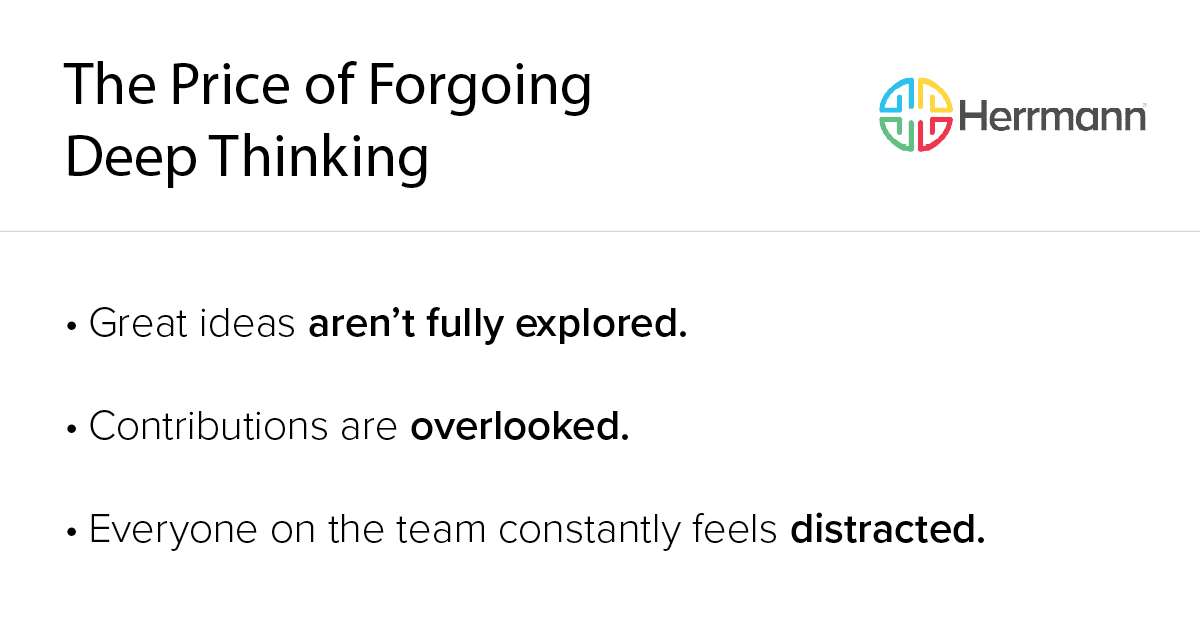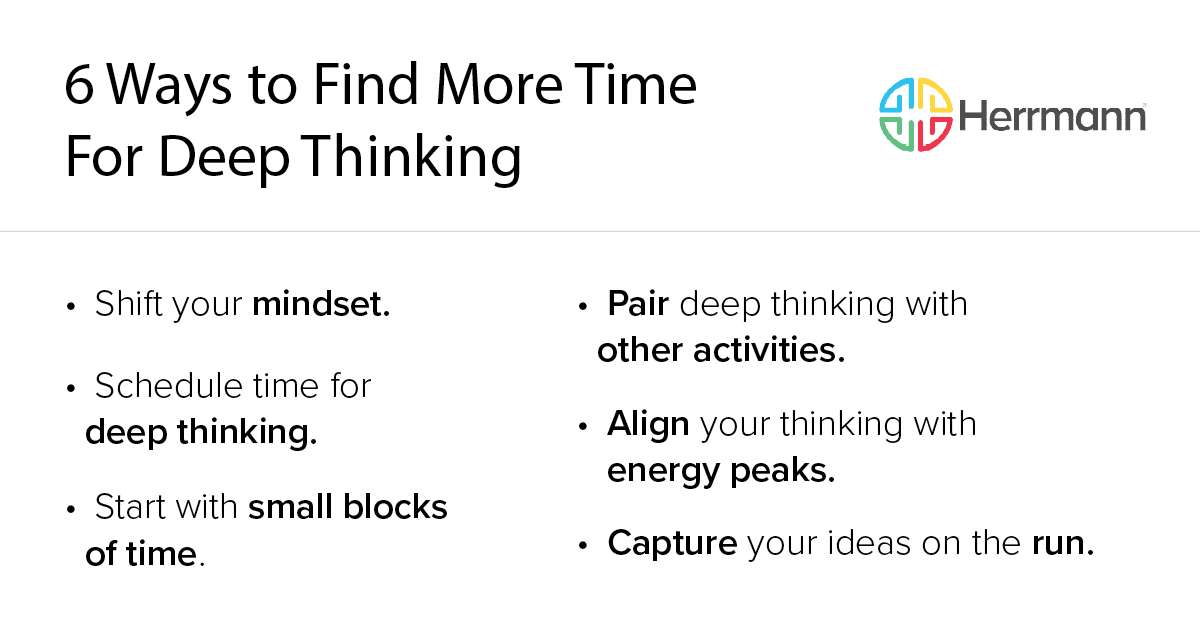Leaders are responsible for managing, guiding, training, coaching and supporting their teams to ensure alignment, growth and success — all while handling your own daily responsibilities. It can feel impossible to make time for deep thinking about your own work.
And yet, you must. Deep thinking elevates your leadership effectiveness, improves your problem-solving abilities and helps you better handle the stressors that naturally come with the role.
Making time for deep thinking allows leaders to be intentional in their actions rather than reactive.
What Is Deep Thinking?
Deep thinking is a state of being where people can concentrate uninterrupted to find creative or outside-the-box solutions. It’s a process where people can open their minds to new possibilities and work through different scenarios and perspectives.
Deep thinking in the workplace is often discussed in terms of deep work, which contrasts with the concept of “shallow work.” These terms come from Cal Newport, the author and associate professor of computer science at Georgetown University. (These two modes of thinking can also be thought of as “fast” and “slow,” as described by psychologist Daniel Kahneman.)
Shallow work describes noncognitive, logistical or minor duties that you can still perform in a state of distraction. People typically don’t come up with complex ideas while in this state. Shallow work occurs without much conscious or active thought. Completing routine paperwork and sitting in meetings where you are not an active participant are two common examples of shallow work.
Deep work, meanwhile, requires the full commitment of your cognitive functioning and can’t occur while you’re distracted. Deep work is challenging and requires sustained focus.
What Happens When We Neglect Deep Thinking
Shallow work is essential to our day-to-day contributions, but deep thinking and deep work are necessary to unlock creativity and innovation.
Teams are busy, and they operate in organizations where speed is of the essence. But productivity isn’t just about speed or quantity, and ignoring the value of deep thinking leads to lost opportunities, poor results and a lack of differences in thinking preferences.
You Can’t Fully Explore Your Ideas
How many thoughts or ideas from today will you remember days or weeks afterward? Most of our thoughts are fleeting, designed to get through whatever is in front of us. That’s OK. But those aren’t necessarily the thoughts that unlock your best, most creative ideas.
While an interesting idea might first emerge during shallow work, you need time to reflect and focus on that idea to fully develop it. Deep thinking allows a person to examine nascent ideas from multiple perspectives, then expand, revise, and build on them. Without that thinking time, those early ideas won’t yield meaningful impact.
Team Members’ Contributions Are Lost or Ignored
You already know how powerful personal reflection can be for exploring your own ideas. That effect compounds when teams put deliberate effort into ideation. That initial, flawed-but-promising idea becomes polished and powerful when cognitive differences are brought to bear.
However, without a cultural and leadership emphasis on deep thinking as a group effort, people will struggle to prioritize finding time to explore ideas together.
Your Team Remains Distracted
Being busy isn’t the same as being productive. Activity isn’t the same as getting things done. When your team only performs shallow work, they can’t focus on big-picture goals or dream about what might be.
Deep thinking requires focus, and when you’re not making time for that, you choose to stay distracted. Distracted teams miss opportunities for growth and warning signs of trouble. They might miss deadlines because they can’t lock in on priorities. And they don’t feel they have the time to explore concepts, go deep into conversation or practice other behaviors that lead to innovation.

6 Ways to Find More Time for Deep Thinking
Deep thinking is a skill you can develop over time, and by practicing deep thinking, you can broaden your perspective.
Shift Your Mindset
Deep thinking doesn’t mean you must try to solve life’s philosophical questions. But you need to examine your thought processes, test your assumptions and see what you might be missing or misinterpreting.
Checking your mindset is an excellent place to start. If you default to action, for example, you might look at deep thinking as a waste of time because it seems you’re just sitting there doing nothing. Shifting your mindset to recast thinking time as a planned, energy-intensive activity can align with your thinking preferences while helping you understand its value.
Schedule Time for Deep Thinking
Leaders aren’t exactly sitting around, waiting for something to do. And in large organizations filled with standing meetings, check-ins and client calls, what gets scheduled is what gets done. So make sure you’re scheduling time for deep thinking.
Leaders set the tone. If you aren’t taking the time for deep thinking, your team won’t feel safe doing so. Don’t just block off time on your calendar; make sure it’s visible to your team.
There’s no one way to schedule deep thinking. Some people want consistent blocks at the same time each day, while others like to divide their day into blocks of time. When Bill Gates was running Microsoft, he would take an entire week away in a cabin. You and your team might not be able to disconnect completely, but you can prioritize thinking time within your workweek.
Start with Small Blocks of Time
Because deep thinking is a skill and habit you can develop, getting started can take time and effort. The good news is you can ease into the process while still getting benefits. Start with 10 to 15 minutes wherever you are. Maybe it’s when you first wake up, during lunch or between meetings.
Teams can incorporate this practice into meetings by taking 10 to 15 minutes to focus on a single question or issue — this dedicated time can make all the difference in having your ideas heard or getting unstuck.
Pair Deep Thinking with Another Activity
Take a walk while you think. Let your brain wander. You can also do this with a friend or colleague. Just ask them: “There’s something on my mind. Would you be willing to listen while I think out loud for a minute?”
While this might sound like shallow work, the difference is that you’re actively talking and listening with another person. That takes intent, energy and focus, just like solitary deep thinking. Deep thinking alone helps you explore your ideas, but talking through ideas with someone else lets in other perspectives. Those conversations can help refocus your attention, gain insight and find a new path forward.
Align Your Deep Thinking Time with Your Energy Peaks
No one can be at the top of their game 24 hours a day. As Daniel Pink wrote in “When,” people have peaks, troughs and recovery periods during their day that affect their output and what type of work they can excel at. If you or your team don’t know your peak times, try identifying your circadian rhythm and scheduling deep thinking around that.
Capture Your Ideas as They Pop Up
You or someone you know might carry around a pen and notebook, jotting ideas or stray thoughts in the moment. That’s a classic way to capture your ideas and inspirations as they occur, knowing that you can reference those insights later on. You might also use your phone, a voice recorder or some other method for tracking these thoughts. This practice isn’t deep thinking in and of itself, but it’s a great way to ensure you can capitalize on nuggets of real-time information, even if that deep thinking doesn’t occur until later.

Why Deep Thinking Makes Teams Better
Great teams are more than the sum of their parts. They combine every individual’s talents and contributions, using collaboration and thinking differences to create better outcomes. Leaders know that this collaborative innovation requires dedicated time for reflection and exploration.
Start with yourself. Are you scheduling time for deep thought? Then look at your team. Are they benefiting from this practice? Do they know how to get started? Show your team how to become deep thinkers, give them the time and resources, and watch as they improve their thinking, collaboration and business outcomes.












